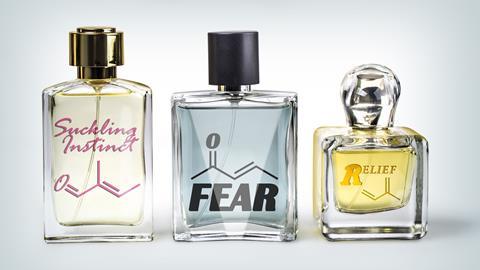Nina Notman sniffs out the evidence for human pheromones and chemical cues
In the 1870s, French entomologist Jean Henri Fabre detected the first evidence for chemical communication. A female emperor moth was placed in a box, and then removed a few hours later. The following day, male moths were found to be mysteriously attracted to the empty container. Fabre realised that what was attracting them had to be chemical by nature – a substance that the female left behind to be later detected by the male.
It took until the late 1950s for the first chemical used to send such a signal to be isolated and identified. German biochemist and chemistry Nobel laureate Adolf Butenandt established that bombykol is used as a sexual attractant by the female silkworm moth. Around the same time, a new name was coined for substances of this type: pheromones.
‘In the 60 years since the chemical identification of bombykol, we have identified thousands of pheromones from thousands of different species across the animal kingdom, particularly in insects but now increasingly in mammals,’ explains Tristram Wyatt, animal behaviour researcher at the University of Oxford, UK. Examples identified so far include a sex pheromone in pigs and elephants, and a mammary signal that triggers suckling in rabbit kits.
This poses an intriguing question: do humans also use chemicals for communication? Our predominantly communication tool may be spoken language, but we constantly use facial and gestural expressions to relay information too. Could pheromones, or other chemical cues, play a role as well without us realising it? The answer is almost definitely yes, explains Wyatt.
A cryptic puzzle
A growing number of behavioural experiments have now provided evidence to support this assumption. But even though the search began in earnest the 1970s, to date no human pheromone has been identified.

Analogous to hormones (the compounds that organisms used to communicate between their own organs to regulate physiology and behaviour), pheromones are chemical signals that send messages between animals of the same species in order to elicit a physiological or behavioural response. They exist for this purpose, and this purpose alone, and the response to them is innate – it is not something that has to be learnt. Some of the identified animal pheromones are single molecules, but more are comprised of multiple compounds in particular ratios.
Also identified in other animals is communication using chemical cues other than pheromones, that is from compounds whose primary role is not communication. To date, around 2000 volatile organic compounds (VOCs) have been identified as being naturally emitted by humans into the air around them (not including artificial compounds from personal care products). These VOCs are breathed out, leach through the skin and are released from urine, faeces and saliva. Chemicals detected so far include alcohols, carboxylic acids, ketones, aldehydes, esters and sulfur compounds.
I don’t think people realise how rich the human volatilome is
Different people have different VOC profiles and the blend of chemicals we emit constantly changes. There is a small genetically determined fixed fraction but the majority is variable, fluctuating constantly depending on our age, diet, health and activity. In addition, some emitted compounds are changed by bacteria on the skin before they become airborne (see box VOCs pop).
‘Animals, including humans, give off a cloud of VOCs, reflecting their internal state. These could perhaps be detected by other individuals as cues to emotional state or health of the emitter,’ explains Wyatt. So that we might know subconsciously to avoid someone with a VOC profile indicative of an infectious disease, for example.
‘This way of communication is usually below the level of consciousness,’ explains Bettina Pause, an experimental psychologist at Heinrich-Heine-University Düsseldorf, Germany. ‘The concentration of the molecules is so low that they’re rarely accompanied by an odour. It’s not olfactory communication, but chemical communication.’
Chemical communications in humans remains a black box for a number of reasons. Firstly, we are behaviourally extraordinarily complex animals. But also, there are still massive gaps in our knowledge regarding what humans emit, especially in different contexts. ‘I don’t think people realise how rich the human volatilome is and how much undecoded information there is in this chemical personal film,’ says Pawel Misztal, indoor air chemist at the University of Texas at Austin, US.
Today, the hunters of human pheromones and chemical cues are very much still searching for a needle in a frequently used haystack.
VOCs pops
Some human-derived VOCs are emitted as large non-volatile precursors and then transformed on the skin by the enzymes of bacteria naturally present there. Examples include the carboxylic acids and sulfur compounds responsible for the stereotypical armpit smell.
Andreas Natsch, an in vitro toxicologist at the flavour and fragrance producer Givaudan in Switzerland, has been working on this. He identified the VOCs responsible for the smell of aged sweat using the gas chromatography–olfactometry technique. ‘At the end of the GC column you have a split, one half [of the sample coming off the column] goes to your detector, and the other half goes to a human nose,’ says Natsch. The precursors were also been identified in fresh sweat collected on pads under armpits within half an hour of exercise and the biochemical pathways between the two identified.
Due to the time lag between production and them being detectable, however, these sweat molecules are not believed to be involved the chemical communication of momentary states of mind. ‘Communicating about individuality is likely for these slowly forming odours, as they are the only ones known to be linked to the genetic background of the sender,’ Natsch explains.
Behavioural issues
Much of the early focus in this field was on identifying human sex pheromones, with molecules proposed so far including four androstene steroids: androstenone, androstenol, androstadienone and estratetraenol. There is no published, peer-reviewed evidence to support the role of these steroids as human pheromones, however, and a growing body of evidence that debunks the claims.

Wyatt considers these steroids to be an unwelcome distraction in the hunt for a human pheromone. In fact, he thinks the identification of any sex pheromone is a long way off. ‘We don’t know enough about human sexual behaviour,’ he explains. ‘To take [that search] forward, we need to identify repeatable, reliable physiological or behavioural sexual responses that are mediated by olfaction,’ says Wyatt. ‘In the absence of these, we’re stopped at first post because we can’t investigate a potential pheromone unless we have a bioassay with which to assess it.’
An easier quest, he explains, might be the identification of a human mammary pheromone that triggers suckling in newborns, such as the one found in rabbit kits in 2003. It was Charles Darwin who first suggested that human newborns are drawn to the nipple by a smell. Experiments have proven, however, that this suckling response is separate from the milk odour. It’s something else that they are drawn towards.
To determine the mammary pheromone in rabbits, Benoist Schaal and his team at the French National Centre for Scientific Research (CNRS) in Dijon passed rabbit milk through a gas chromatograph equipped with both a sniffing device and a flame ionization detector. This allowed for concurrent detection and identification. The pups were positioned by the sniffing port and observed for signs such as moving their heads towards it. As a result, ‘we were able to reduce the complexity of the profile from 150 volatile compounds to only 20’, explains Schaal. When these 20 compounds were presented separately to the pups it was found that they only reacted to one: 2-methylbut-2-enal.
The team is now looking to identify mammary pheromones in other mammals, including humans. The challenge with the latter is the sluggish response of human newborns to the nipple. Rabbit kits, by contrast, display a very rapid and highly predictable behaviour when given the opportunity to suckle. ‘We are using a different, much more time consuming and costly strategy of trying to identifying what [VOCs are] common to a great number of milks from different [human] mothers,’ says Schaal. That group of compounds will then be tested individually against babies in a yet to be determined behavioural test.
Insect work
For insects, it is possible to circumvent the need for a troublesome behavioural aspect to these tests by using an electroantennogram assay to listen in to their message reception system. Originally developed in the 1950s, this technique involves attaching two electrodes at opposite ends of an insect’s antenna. ‘When the nerve cells fire in response to an olfactory cue there is a change in standing potential’ between the electrodes that can be measured, explains John Pickett, a chemical ecologist at Cardiff University, UK.
It will eventually be possible to use insects in the quest to understand human chemical communications
Pickett’s group have used this technique to help them identify pheromones in secretions from a number of insects including mosquitoes and aphids. They pass complex mixtures containing suspected pheromones through a high-resolution capillary gas chromatograph equipped with both an electroantennogram assay and a flame ionisation detector. This allows for concurrent detection and identification of any pheromones among the separated components.
They have also been able to study the olfactory systems of more complex insects using genetically modified tractable insects such as the fruit fly. The transgenic olfactory receptor of another insect such as a beneficial parasitic wasp that attacks pests can be placed into the empty neuron of the fruit fly, says Pickett.
Ultimately, he hopes to ‘get the human olfactory receptors into an insect so we can interrogate it using the intact amplification system’. Pickett admits this may sound ‘a bit pie in the sky’, but he maintains it will eventually be possible to use insects in the quest to understand human chemical communications.
Moody blues
A research area further forward is the understanding of how humans use chemical cues to subconsciously convey emotional states. Behavioural experiments have now provided empirical evidence that not only we do convey fear and anxiety chemically, but that it then spreads through in a crowd. ‘Numerous studies demonstrate that fear and anxiety in humans is contagious,’ explains Pause. ‘The sender feels anxiety, sends the chemosignal for anxiety to the receiver, who then gets into a state similar to anxiety.’
We found that the composition of body odour from three different emotional states was significantly different
Pause and her group recently started to study aggression by monitoring the brain activity of volunteers (using an electroencephalogram) while they sniff sweat collected from different volunteers in a neutral and the aggressive mindset. ‘We found that women reacted more strongly to male aggression than men did, with brain activations within the dorsomedial prefrontal cortex,’ says Pause. Activations in this area of the brain are indicative that the volunteers were translating the negative social responses into threat-related physiological changes, she adds. These could be related to aggression or fear, depending on the context.
Pause does not look for the chemicals behind these signals, but other researchers are now starting to search for the VOC profile fingerprints indicative of different human emotional states. Monique Smeets, a Dutch experimental psychologist who splits her time between Utrecht University and Unilever R&D, and her team recently published a preliminary effort to identify the chemical variations in sweat collected from volunteers in a fearful, happy and emotionally neutral state.
‘We collected body odour from males who were fearful, the same males when they were happy, and the same males when they were in a neutral state, and subjected that to chemical analysis using gas chromatography–mass spectrometry,’ says Smeets. ‘We found that the composition of the body odour from the three states was significantly different.’
The team looked at 1655 VOCs and chemical classes identified include linear aldehydes, ketones, esters and molecules with five-membered rings. Differences found include more linear aldehydes and ketones in the fear sweat compared to when the volunteers were in a neutral state.
Reading the room
Smeets’ team of psychologists collected sweat samples on underarm pads for half an hour, and then preserved them by freezing before sending them for chemical analysis. But chemists – and their instruments – are now starting to get involved in the sample collecting stage too.

Proton transfer reaction time-of-flight mass spectrometry (PTR-TOF-MS) instruments, originally developed for measuring trace VOCs in the atmosphere, open up the possibility of revealing how the chemical fingerprints of emotion change over very short time scales. These instruments can take measurements in real time.
‘It reminds me how atmospheric chemistry developed,’ explains Misztal. ‘The first time people did measurements in the atmosphere, they found nitrogen, oxygen, argon, carbon dioxide and said “These are inert gases, there’s no atmospheric chemistry.” But then when the instruments became sensitive enough they found millions of reactions actually happening.’ The same is now happening with the field of human chemical communication, he says.
The first atmospheric chemist to enter this research field was Jonathan Williams, from the Max Planck Institute for Chemistry in Mainz, Germany. In 2012, his team took a PTR-TOF-MS to sniff the air inside a football stadium in Mainz. The aim was to measure the chemical fingerprint of exhilaration in the crowd after a goal. Although this wasn’t possible – the match they measured at ended in a nil–nil draw – their data was a treasure trove of interesting titbits and a good demonstration of the prowess of their instrument for studying human emissions. They detected, for example, VOCs from skin oxidation by ozone in the air inside the stadium.
The chemists and their instrument then decamped to the local cinema, figuring this location would give them both guaranteed audience emotional responses and multiple reproducible events to measure. ‘It’s a big multiplex cinema where the same films are shown several times,’ says Williams. ‘That allowed us to test the reproducibility of any chemical signals.’ The cinema screening rooms are constantly flushed with fresh air, and the PTR-TOF-MS was positioned in the air outlet ventilation shaft.
‘We saw that when particularly exciting moments in films occurred, we could overlay more or less the chemical signals from the cinema air from different screenings and see peaks occurring always at the same time in the film,’ says Williams. This reproducibility is key in a field that has been plagued in the past by studies with questionable results, he adds.
The data show clear differences when people change their emotional state
The chemists then collaborated with a data mining group to time stamp all the significant events in the films with labels such as fighting and kissing. These were then matched up with the chemicals being measured at those stages in the screenings. One thing that is very visible in the data was that the strength of the isoprene signal connected extremely well to fear, says Williams. And he thinks he knows why that is. It’s well known that we make isoprene and store it in our muscle tissue. When we move around, more blood passes through the muscle and flushes the isoprene out, which then leaves the body in our breath. Williams suggests that the peaks are caused by the audience holding their breath (and then exhaling simultaneously when the hero arrives) or by twitching or tensing muscles in response to the scenes on the screen.
Williams is keen to get his instruments back into the cinema to learn more once the coronavirus pandemic has passed. His work has also inspired another atmospheric chemist into the field: Ben Langford at the UK Centre for Ecology and Hydrology (UKCEH) in Edinburgh.
Recently, Langford collaborated with University of Stirling psychologist Craig Roberts and indoor air chemist Misztal (then in UKCEH too) to test a specially designed under-the-armpit sampling port attached to a PTR-TOF-MS. Volunteers were then shown neutral and scary video scenes. ‘These data still need to be further analysed,’ explains Misztal, ‘but what we have analysed already show clear differences when people change their emotional state.’ During scary scenes, for example, acetone emission rates rapidly increase while butanone rapidly decreases.
Misztal says he was particularly fascinated by the immediacy of the release of some of the VOCs. ‘I was expecting that there should be some time lag while the body synthesises these chemicals, then they travel through the skin and then you would measure them,’ he explains. ‘But some compounds responded almost immediately.’ This could, potentially, indicate their use in chemical communication.
Misztal moved to Texas in September 2019, where he is now collaborating with psychologists Robert Josephs and James Pennebaker to use PTR-TOF-MS to study the chemistry behind the so-called smell of fear and the effect of stress on human volatilome.
‘I think in the next 10 years we’ll see basically a revolution in understanding the human volatilome,’ says Misztal. As well as being fundamentally interesting, decoding these chemical signals may allow for practical applications such as encouraging suckling in struggling newborns, rapid detection of conditions such as cancer, post-traumatic stress disorder or even covid-19 – and, yes, maybe even in attracting new sexual partners.
Nina Notman is a science writer based in Salisbury, UK













1 Reader's comment